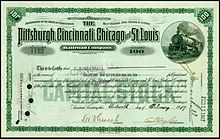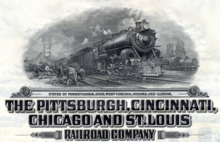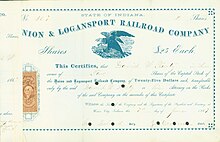Pittsburgh, Cincinnati, Chicago and St. Louis Railroad
This article includes a list of general references, but it lacks sufficient corresponding inline citations. (January 2013) |
 | |
| Overview | |
|---|---|
| Locale | standard gauge |
| Overview | |
|---|---|
| Locale | Chicago, St. Louis and Pittsburgh Railroad; Cincinnati and Richmond Railroad; & Jeffersonville, Madison and Indianapolis Railroad |
| Successor | Pittsburgh, Cincinnati, Chicago and St. Louis Railroad |


The Pittsburgh, Cincinnati, Chicago and St. Louis Railroad, commonly called the Pan Handle Route (Panhandle Route in later days), was a
History
Pittsburgh to Columbus (1848–1869)
The Steubenville and Indiana Railroad was chartered February 24, 1848, in
The line began construction in late October 1851.[1] Work occurred along the entire length of the line at the same time.[2]
The first section opened December 22, 1853, from Steubenville west to Unionport.[3] On February 2, 1854, an extension from Unionport west to Cadiz Junction opened; the branch to Cadiz opened June 12. Further extensions west from Cadiz Junction opened June 22 to Masterville, July 12 to Bowerston, and April 11, 1855, the rest of the way to Newark.[3] However, it did not yet connect to any other railroads in Newark.
On December 25, 1854, the S&I came to an agreement with the Central Ohio Railroad to use its tracks from Newark west to Columbus. Some surveying had been done for a separate route via Granville. The connection at Newark opened April 16, 1857, and was built with funds provided by the Columbus and Xenia Railroad, which helped provide a through route to Cincinnati from the S&I. In 1864, the S&I outright bought a half interest in the Newark–Columbus track.
The Pittsburgh and Steubenville Railroad was chartered March 24, 1849, in Pennsylvania to build west from the Monongahela River near Pittsburgh to the Virginia (now West Virginia) state line towards the Steubenville and Indiana Railroad. It was authorized to extend across the Monongahela to Pittsburgh on April 21, 1852. The Western Transportation Company was incorporated by the Pennsylvania Railroad in Pennsylvania on March 15, 1856, to build and operate the P&S.
On July 22, 1853, the president of the S&I deeded right-of-way he had bought from 36 landowners across the
The full P&S opened October 9, 1865, from
The P&S was sold under foreclosure on November 6, 1867, to the Panhandle Railway, which had been chartered April 8, 1861. On April 30, 1868, the PHRy, S&I and HCRR merged to form the Pittsburgh, Cincinnati and St. Louis Railway, and the Western Transportation Company was dissolved soon after.
Columbus to Indianapolis (1847–1867)
The
and Columbus and Xenia Railroad at Dayton.The Columbus, Piqua & Indiana Railroad was chartered in Ohio on February 23, 1849, to build from Columbus west via
The Richmond and Covington Railroad was chartered in Ohio by the Indiana Central Railway and Columbus, Piqua and Indiana Railroad on March 12, 1862, to build a branch of the latter from Bradford to the former at the Indiana state line near New Paris. The R&C opened in early 1863, and the Indiana Central's joint operating contract with the Dayton and Western Railroad was dissolved on March 9. On January 10, 1864, the IC, C&I and R&C signed an agreement for joint operation as the Great Central Line between Columbus and Indianapolis, headed by the Indiana Central. The C&I bought the R&C on September 5, 1864. The Indiana Central Railway and Columbus and Indianapolis Railroad merged October 19 to form the Columbus and Indianapolis Central Railway, with a main line from Columbus to Indianapolis and a branch from Bradford, Ohio, to Union City, Indiana.
Richmond to Chicago (1848–1865)
The New Castle and Richmond Railroad was chartered February 16, 1848, in Indiana to build a line from
The Cincinnati, Cambridge and Chicago Short Line Railway was incorporated in Indiana on January 25, 1853, to build from New Castle southeast via Cambridge to the Ohio state line; the Cincinnati, New Castle and Michigan Railroad was incorporated April 11 of the same year to build northwest from New Castle towards St. Joseph, Michigan. The two companies merged May 1, 1854, to form the Cincinnati and Chicago Railroad. On October 10, 1854, the Cincinnati, Logansport and Chicago Railway was merged into the Cincinnati and Chicago Railroad. The unfinished line between Richmond and Logansport was leased to John W. Wright and Company on October 16, 1856. That company began operating it on December 1, and the joint operation towards Cincinnati ended. The full line between Richmond and Logansport opened on July 4, 1857. That line was sold at foreclosure on April 28, 1860, and reorganized July 10 as the Cincinnati and Chicago Air-Line Railroad. Grading had been done from Wabash southeast to the Ohio state line; portions were later sold to the Fort Wayne and Southern Railroad and Connersville and New Castle Junction Railroad.
On September 25, 1857, the Chicago and Cincinnati Railroad was chartered in Indiana to build a line from Logansport northwest to Valparaiso. That line opened in 1861, connecting at Valparaiso with the Pittsburgh, Fort Wayne and Chicago Railway to Chicago. The Cincinnati and Chicago Air-Line opened a bridge over the Wabash River at Logansport on September 25, 1861, connecting it to the Chicago and Cincinnati. Joint operation between Richmond and Chicago began July 1, 1862, and ended January 29, 1865.
Realignments towards Chicago and mergers (1857–1869)
The Galena and Illinois River Railroad was chartered in Illinois on February 18, 1857,

The Marion and Mississinewa Valley Railroad was incorporated in Indiana on May 11, 1852, to build from
In the meantime, the


On September 11, 1867, the Columbus and Indianapolis Central Railway, Union and Logansport Railroad and Toledo, Logansport and Burlington Railway merged to form the Columbus and Indiana Central Railway. The main line, formerly being built by the Union and Logansport, opened from Union City to Marion in October 1867.
On February 12, 1868, the Columbus, Chicago and Indiana Central Railway was formed as a merger of the Columbus and Indiana Central Railway and Chicago and Great Eastern Railway. The rest of the new main line, from Marion northwest to
Expansion (1869–1890)

On December 1, 1869 (retroactive from February 23, 1870) the Pittsburgh, Cincinnati and St. Louis Railway leased the
With the 1870 completion of the
The Columbus, Chicago and Indiana Central Railway went bankrupt and was sold at foreclosure on January 10, 1883. The Chicago, St. Louis and Pittsburgh Railroad was incorporated in Indiana on March 14 and Illinois on March 15, and the former CC&IC was conveyed to the two companies on March 17. Operation by the PC&StL continued until April 1, 1883. On April 1, 1884, the two companies merged to form one Chicago, St. Louis and Pittsburgh Railroad. That company was merged with the PC&StL, Cincinnati and Richmond Railroad and Jeffersonville, Madison and Indianapolis Railroad on September 30, 1890, to form the Pittsburgh, Cincinnati, Chicago and St. Louis Railway (PCC&StL).
20th century
In 1891, the PCC&StL acquired stock ownership of the Little Miami Railroad. On December 21, 1916 (taking effect January 1, 1917), the Pittsburgh, Cincinnati, Chicago and St. Louis Railway merged with the Vandalia Railroad, Pittsburgh, Wheeling and Kentucky Railroad, Anderson Belt Railway and Chicago, Indiana and Eastern Railway, forming the Pittsburgh, Cincinnati, Chicago and St. Louis Railroad.
The PCC&StL was leased by the PRR on January 1, 1921, and finally was merged into the PRR's Philadelphia, Baltimore and Washington Railroad on April 2, 1956.
Current use
Sections of the route have been adapted for other uses. The easternmost section, from the Pittsburgh
Branches
- Chartiers
- Dunkirk
- New Cumberland
- Wheeling, Indiana
- Muncie
- Effner
- Shelbyville
- Madison
See also
- Main Line (Pittsburgh to St. Louis)
- Panhandle Bridge
- Panhandle Trail
- Pittsburgh & Steubenville Extension Railroad Tunnel
References
- ^ "Steubenville and Indiana Railroad". Pittsburgh Daily Post. October 29, 1851. p. 2.
- ^ "Pittsburgh and Steubenville Railroad". The Baltimore Sun. July 29, 1852. p. 1.
- ^ OCLC 807914.
- ^ Morris, J. C., ed. (December 31, 1902). Ohio Railway Report: Annual Report of the Commissioner of Railroads and Telegraphs; Part II. History of the Railroads of Ohio. Retrieved February 18, 2010.
